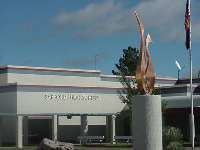Type Public secondary Principal Rich DeRidder Enrollment 854 Phone +1 928-348-7050 Founded 1915 | Established 1915 Faculty 79 Website [2] Mascot Bulldog Colors White, Blue | |
 | ||
Address 1400 W 11th St, Safford, AZ 85546, USA Similar Thatcher High School, Eastern Arizona College, Pima Unified School Di, Eastern Arizona Courier, Morenci Public Schools | ||
Safford High School, of the Safford Unified School District, is one of two public high schools in Safford, Arizona. The campus hosts the Safford Center for the Arts, located on the north lot of the campus property. As of the 2008 school year, the school had a staff population of 79 and a student population of 854.
Contents
- Safford high school bomb threat hoax
- History of the SHS campus
- Original SHS campus
- Current SHS campus
- Athletics history
- Notable alumni
- School resource officer
- References
Safford high school bomb threat hoax
History of the SHS campus
Safford High School was established as an institution in 1915.
Original SHS campus
The original Safford High School building, which was located where Safford Middle School is currently located, opened to students on September 13, 1915. It was designed by Henry O. Jaastad. It served as the main high school building through the 1979-80 school year. Over the years other buildings were built. This included the WPA-built Baker Stadium, which served as the home of the Safford Bulldogs from 1938 through the 1986 season; a gymnasium in 1943, which allowed the previous gym to be retrofitted into an auditorium; and the other classroom buildings. This included a library built in the 1960s. It is noted that, during this period, the baseball stadium was at the old bleachers by Lafe Nelson School as was the field house for the football and wrestling teams.
Once the high school moved to its current campus, the original Safford Junior High School, which had its own building adjacent to the high school, was torn down in 1980. Safford Junior High, then later Middle, School occupied the main building and the gymnasium until the mid-1990s, when concerns for those buildings' safety and revelations of poor construction quality prompted them to be razed and replaced, outweighing concerns of historical value and the cost of a refurbishment. The 1915 building was listed on the National Register of Historic Places on February 9, 1988. It remains listed, apparently erroneously as the building is gone. Ultimately, shoddy construction was also the reason that the 1943 gymnasium was torn down in the 1990s. Baker Stadium is still used as the home field for middle school football.
Current SHS campus
The current SHS campus was carved out of cotton fields in 1980. The superintendent at that time was Ray Evans. Donald Wilson had retired in 1978. The current campus was built in bits and pieces over the course of two and a half decades. The original plan for the high school was not completed, with some modification, until the opening of the new auditorium in 2006. When opened there was just the main classroom building and the gym. They were painted brown. In 1985, under the guidance of Superintendent Ron Starcher, the high school was repainted its current slightly cream/beige color. A teacher at the time termed the new paint job, "Very much an improvement." There was also just one paved road to the school, 11th Street. During the 1984-85 school years the roads connecting the school to Relation Street and to 20th Ave were completed. In 1986 a bond issue passed that allowed for the cafeteria, orchestra pit, and shop building that connects the gym and main building to be built. It also approved the construction of the current football stadium and track. Until that time there was no cafeteria, just a snack bar, all of the shop students still had to go over to the junior high, and all home track meets were at EAC. All of these new facilities were opened by the 1987-88 school year. It was in this year the current bus barn was added. Then in 1990 the current baseball stadium and tennis courts were developed and later softball fields were developed when that sport was added. In the late 1990s the road connecting the school to Eighth Street was completed. In 2000 the new second gym and wrestling rooms was added to the building. Then in 2006 the auditorium was finished.
Athletics history
Safford High School's most successful athletics programs have been volleyball, wrestling, and track. Under Coach Norma Bellamy, the Bulldogs won 21 state volleyball championships, a national record. The last of these came in 1990. Bellamy had a record of 520-33, a national record for win percentage for coaches with over 500 wins (.940). She was named Arizona Coach of the Century in Volleyball. The boys' track team has won 14 outright state titles, while the girls' have won 19. B.B. Andrews also won Arizona Coach of the Century for the girls' track program, with 15 titles. He also presided over a national record 13 consecutive girls' championships from 1986-1998. He has also won 10 titles with the boys', the last of which came from 2008. Safford's wrestling program has been dominant recently, winning 6 straight team state championships from 2005-2010. Baseball has won four championships, boys' basketball has won three, girls' basketball has won one, golf has won two, boys' tennis has won 2, and girls' tennis has won 6. Safford has won a total of 78 state championships, with numerous individual champions during and outside of those reigns.
Notable alumni
School resource officer
As of 2008, the school has one school resource officer assigned to it from the Safford Police Department.
